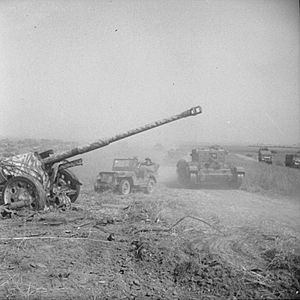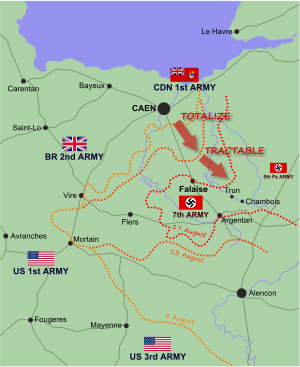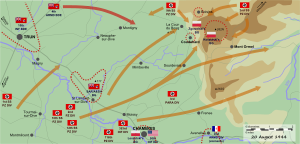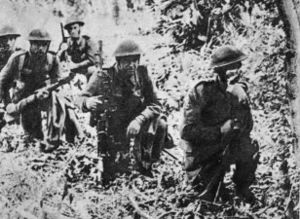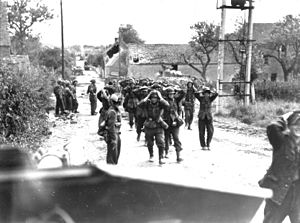Falaise pocket facts for kids
Quick facts for kids Battle of the Falaise pocket |
|||||||
|---|---|---|---|---|---|---|---|
| Part of the Normandy Campaign | |||||||
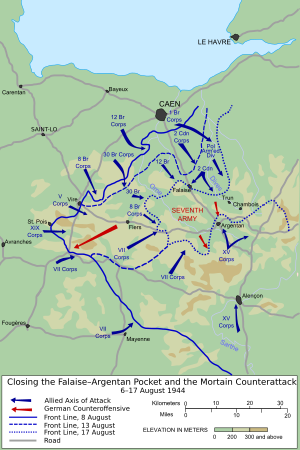 Map showing the course of the battle from 8–17 August 1944 |
|||||||
|
|||||||
| Belligerents | |||||||
| Commanders and leaders | |||||||
| Units involved | |||||||
| Strength | |||||||
| Up to 17 divisions | 14–15 divisions | ||||||
| Casualties and losses | |||||||
| United States: Unknown United Kingdom: Unknown Free French: Unknown Canada: 5,679 casualties Poland: est. 5,150 casualties in total of which 2,300 for the 1st Armoured Division. |
est. 60,000:
|
||||||
The Falaise Pocket was a very important battle during the Normandy Campaign in World War II. It happened from August 12 to 21, 1944. Allied forces, including soldiers from the United States, Britain, Canada, Poland, and France, managed to trap a large German army group near the town of Falaise, Calvados in France. This battle led to a huge victory for the Allies. It destroyed most of the German forces in the area and opened the way for the Allies to advance towards Paris and the German border.
Contents
The Battle's Beginning
Six weeks after the D-Day invasion of Normandy on June 6, 1944, the German army was in trouble. The Allies had faced strong resistance. British forces had hoped to free Caen quickly, but it took almost two months. American forces also expected to control Saint-Lô by June 7, but German resistance delayed this.
However, the German army used up many valuable resources defending their lines. Allied air forces controlled the skies far behind enemy lines. They constantly bombed German supply routes, making it hard for Germans to get fuel and ammunition. The Germans had used their reserve tanks to defend Caen, leaving few troops for other defenses.
The Allies planned a multi-step attack. First, British and Canadian forces attacked near Caen in Operation Goodwood on July 18. The Germans sent many of their tanks to stop this. Then, on July 25, American bombers dropped thousands of bombs on German lines near Saint-Lô in Operation Cobra. This created a gap, and American forces broke through.
On August 1, General George S. Patton took command of the new US Third Army. This army quickly pushed south and then east, facing little resistance. At the same time, British and Canadian troops pushed south in Operation Bluecoat. This kept the German tanks busy. The Germans were forced to retreat, but their withdrawal soon fell apart because they ran out of fuel.
German leader Adolf Hitler would not let his commander, Field Marshal Günther von Kluge, pull back. Instead, Hitler ordered a counter-attack called Operation Lüttich against the Americans. But four weakened German tank divisions were not enough. This attack failed and pushed the Germans deeper into the Allied trap.
On August 8, General Bernard Montgomery, the Allied ground commander, ordered his armies to meet near Falaise and Chambois. The American army would form the southern part of the trap. The British would be the base, and the Canadians would be the northern part. The Germans began to retreat on August 17. On August 19, the Allied forces met in Chambois.
The Germans tried to break out, creating gaps in the Allied lines. The biggest gap was forced past the 1st Polish Armoured Division on Hill 262. This hill was a key position at the mouth of the trap. By the evening of August 21, the trap was sealed. About 50,000 German soldiers were caught inside. Many Germans escaped, but their losses were huge. The Allies freed Paris a few days later. By August 30, the remaining German forces retreated across the Seine River, ending the Normandy campaign.
Why the Battle Happened
The Normandy Invasion
The first goals for the Allies after D-Day were to capture the port of Cherbourg and the area around Caen. Allied attacks quickly defeated early German attempts to stop the invasion. But bad weather delayed Allied supplies and troops. This allowed the Germans to move their own forces more easily. Cherbourg was captured by American forces on June 27. The Germans defended Caen until July 20, when British and Canadian forces took the southern parts of the town.
General Bernard Montgomery, the Allied ground commander, planned to draw German forces to the east. This would keep them busy fighting the British and Canadians. Meanwhile, the US First Army would advance down the west side of the Cotentin Peninsula to Avranches. On July 25, the US First Army, led by Lieutenant-General Omar Bradley, started Operation Cobra. They broke through German defenses near Saint-Lô. Within three days, they had advanced 15 miles (24 km) south. Avranches was captured on July 30. Within 24 hours, the US Third Army crossed a bridge at Pontaubault and moved into Brittany. They faced almost no resistance.
German Counter-Attack
The American advance was very fast. By August 8, Le Mans, which was the German 7th Army's headquarters, had been captured. After several Allied operations, the German army in Normandy was very weak. On the Eastern Front, a huge Soviet attack meant Germany could not send any more troops to France.
Adolf Hitler ordered Field Marshal Günther von Kluge, the new commander of the German forces, to launch an "immediate counter-attack" near Mortain. Hitler wanted to destroy the enemy and reach the coast. Eight of the nine German tank divisions in Normandy were supposed to be used. But only four could be ready in time. German commanders argued that their forces were too weak for an attack. But Hitler ignored them.
Operation Lüttich began on August 7 near Mortain. The first attacks were made by three German tank divisions. But they had only a small number of tanks. The Allies knew about the attack because they had intercepted German messages. The German attack continued until August 13, but the main threat was over within 24 hours. This operation led to Germany's strongest remaining units being defeated. The German front in Normandy was about to collapse.
Pushing Towards Falaise
The First Canadian Army was ordered to capture high ground north of Falaise. This would help trap the German army. The Canadians planned Operation Totalize. This involved attacks by bombers and a new night attack using special armored vehicles called Kangaroos. Operation Totalize began on the night of August 7/8. Infantry rode on the Kangaroos, guided by electronic tools. They attacked the German 12th SS Panzer Division.
Verrières Ridge and Cintheaux were captured on August 9. But German resistance and some poor Canadian leadership slowed the advance. This led to many casualties for the Canadian and Polish armored divisions. By August 10, Allied forces had reached Hill 195, north of Falaise. The next day, the Canadian commander ended the attack.
Allied Plan to Trap the Germans
General Montgomery still expected the Germans to try to escape. He had been planning a "long encirclement." This meant the British and Canadians would move from Falaise towards the Seine River. The US Third Army would block the escape route between the Seine and the Loire River. This would trap all remaining German forces in western France.
On August 8, the Supreme Allied Commander, General Dwight D. Eisenhower, suggested a shorter trap at Argentan. Montgomery and Patton were worried that if they didn't capture Argentan, Alençon, and Falaise quickly, many Germans might escape. Montgomery agreed to Bradley's plan for the shorter trap. He believed he could always go back to the original plan if needed.
The Battle of the Pocket
This battle is also called the Falaise Gap because it refers to the narrow corridor the Germans tried to use to escape.
Closing the Trap
The US Third Army advanced well from the south on August 12. Alençon was captured. This forced the German commander, Kluge, to use troops he had saved for a counter-attack. The next day, the US 5th Armored Division advanced 35 miles (56 km) and reached positions overlooking Argentan. On August 13, General Bradley stopped Patton's order for the 5th Armored Division to push further north towards Falaise. Bradley ordered the US troops near Argentan to pull back. This ended the pincer movement by the US forces. Patton disagreed but followed the order. This left an exit for the German forces in the Falaise pocket.
With the Americans halted in the south, and the British pushing from the north-west, the First Canadian Army, which included the Polish 1st Armoured Division, was ordered to close the trap. After a small attack on August 12–13, most of the time was spent preparing for Operation Tractable. This was a planned attack on Falaise. The operation began on August 14 at 11:42 AM. It was covered by a smoke screen, like the night attack in Operation Totalize. The Canadian and Polish armored divisions crossed the Laison River. But delays at the Dives River gave German Tiger tanks time to counter-attack.
Moving through the smoke was slow. Also, the Canadian army mistakenly used yellow smoke to mark their positions. This was the same color bombers used to mark targets. This led to some accidental bombing of Canadian troops and slowed progress. On August 15, Canadian divisions continued the attack, but progress remained slow. The 4th Armoured Division captured Soulangy against strong German resistance. Several German counter-attacks prevented a breakthrough to Trun. The next day, the 2nd Canadian Infantry Division entered Falaise. They faced minor resistance from German units. By August 17, they had secured the town.
At midday on August 16, Kluge refused an order from Hitler for another counter-attack. In the afternoon, Hitler agreed to a withdrawal. But Hitler became suspicious that Kluge planned to surrender. Kluge was replaced by Field Marshal Walter Model. Model's first action was to order the immediate retreat of the German 7th Army and Fifth Panzer Army. Other German units held the escape route open against the British, Canadians, and Americans.
During the retreat, Allied fighter bombers constantly attacked German columns. They used bombs, rockets, and guns. This turned the escape routes into deadly areas. Even though many tanks and vehicles were claimed to be destroyed from the air, later investigations showed that only a few armored vehicles were confirmed to be destroyed by aircraft. However, many trucks were lost to air attacks, or abandoned by their crews because of the air threat.
The Encirclement Closes
On August 17, the trap was still not fully closed. The 1st Polish Armoured Division was ordered to sweep south-east to meet American troops at Chambois. Trun fell to the 4th Canadian Armoured Division on August 18. After capturing Champeaux on August 19, the Polish groups moved towards Chambois. With help from the 4th Canadian Armoured Division, the Poles secured the town. They linked up with American and French divisions by evening.
The Allies did not yet fully block the German escape route. German troops inside the pocket attacked their positions. A German tank column broke through the Canadians in St. Lambert. They took half the village and kept a road open for six hours until nightfall. Many Germans escaped through this gap.
After taking Chambois, two Polish groups drove north-east. They set up positions on part of Hill 262 (Mont Ormel ridge). They spent the night of August 19 digging in. The next morning, the German commander, Model, ordered attacks from outside the pocket towards the Polish positions. Around midday, several German units managed to break through the Polish lines and open a corridor. Another German division prevented the Canadians from interfering. By mid-afternoon, about 10,000 German troops had escaped the pocket.
The Poles held on to Hill 262, which they called "The Mace." From their high position, they could direct artillery fire onto the retreating Germans. The German 7th Army commander ordered the Polish positions to be "eliminated." Remaining German infantry and tank units attacked the Polish Division. They caused many casualties, but the Poles fought them off. They used almost all their ammunition. The Poles watched as the last German tank corps escaped. There was fighting throughout the night, and the Poles called for frequent artillery strikes to stop the German retreat.
German attacks continued the next morning, but the Poles kept their hold on the ridge. Around 11:00 AM, a final attack by German SS troops was launched. It was defeated in close-quarters fighting. Soon after midday, Canadian troops reached Mont Ormel. By late afternoon, the remaining German SS Panzer Divisions began their retreat to the Seine River. For the Falaise pocket operation, the 1st Polish Armoured Division had 1,441 casualties, including 466 killed. Their losses at Mont Ormel were 351 killed and wounded, with eleven tanks lost. German losses in their attacks on the ridge were about 500 killed and 1,000 captured. Many German tanks and artillery pieces were destroyed.
By the evening of August 21, Canadian tanks had linked with Polish forces. Other Canadian divisions had secured St. Lambert and the northern passage to Chambois. The Falaise pocket was sealed. Around 20,000 to 50,000 German troops, without their heavy equipment, escaped through the gap. They were later reorganized and rearmed. This allowed them to slow the Allied advance into Eastern France, the Netherlands, Belgium, and Germany.
What Happened Next
Losses
By August 22, all German forces west of the Allied lines were either dead or captured. Historians have different ideas about how many Germans were lost in the pocket. Most say that between 80,000 and 100,000 troops were trapped. Of these, about 10,000 to 15,000 were killed, and 40,000 to 50,000 were taken prisoner. Between 20,000 and 50,000 managed to escape.
In the northern part of the battle, German losses included 344 tanks, self-propelled guns, and other light armored vehicles. They also lost 2,447 soft-skinned vehicles (like trucks) and 252 guns that were abandoned or destroyed. In the fighting around Hill 262, German losses were about 2,000 men killed and 5,000 captured. They also lost 55 tanks, 44 guns, and 152 other armored vehicles.
By August 22, 1944, the German 12th SS-Panzer Division had lost about 8,000 men out of its original 20,540. It also lost most of its tanks and vehicles. Even though some German units escaped to the east, they left most of their equipment behind. After the battle, Allied investigators estimated that the Germans lost around 500 tanks and assault guns in the pocket. Very little of the equipment that escaped survived the retreat across the Seine River.
Images for kids
See also
- Allied advance from Paris to the Rhine
- Battle of the Mons Pocket
- Colmar Pocket
- Liberation of France


